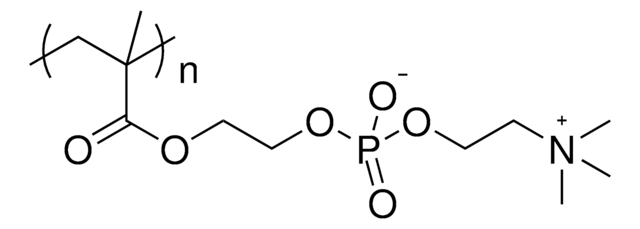925640
Poly (ethylene glycol)-block-Poly (sulfobetaine methacrylate)
PEG average Mn 5000, PSBMA Mn 13,000
Sinônimo(s):
PEG-PDMAPS, PEG-PSBMA, PSBMA, Poly (sulfobetaine methacrylate)
Faça loginpara ver os preços organizacionais e de contrato
About This Item
Fórmula linear:
CH3(C2H4O)nC6H7O2N(C11H21O5NS)mOH
Código UNSPSC:
12352112
NACRES:
NA.23
Produtos recomendados
peso molecular
PEG average Mn 5000
PSBMA Mn 13,000
Nível de qualidade
Categorias relacionadas
Aplicação
Biocompatible, non-fouling block copolymer composed of a neutral PEG block and a zwitterionic poly(sulfobetaine methacrylate) (PSBMA) block.
Poly(sulfobetaine methacrylate) (PSBMA) is a well-known zwitterionic polymer, it is non-toxic and biocompatible. On each of its repeating unit, it carries both a positive charge and a negative charge, leading to its strong hydration capacity.
Surfaces coated with PSBMA showed super hydrophilic property and strong resistance to protein adsorption/bacterial adhesion, making this polymer a promising material in anti-fouling applications.
Poly(sulfobetaine methacrylate) (PSBMA) is a well-known zwitterionic polymer, it is non-toxic and biocompatible. On each of its repeating unit, it carries both a positive charge and a negative charge, leading to its strong hydration capacity.
Surfaces coated with PSBMA showed super hydrophilic property and strong resistance to protein adsorption/bacterial adhesion, making this polymer a promising material in anti-fouling applications.
Código de classe de armazenamento
11 - Combustible Solids
Classe de risco de água (WGK)
WGK 3
Ponto de fulgor (°F)
Not applicable
Ponto de fulgor (°C)
Not applicable
Escolha uma das versões mais recentes:
Certificados de análise (COA)
Lot/Batch Number
It looks like we've run into a problem, but you can still download Certificates of Analysis from our Documentos section.
Se precisar de ajuda, entre em contato Atendimento ao cliente
Já possui este produto?
Encontre a documentação dos produtos que você adquiriu recentemente na biblioteca de documentos.
Jiang Wu et al.
Acta biomaterialia, 40, 172-181 (2016-05-05)
Nonfouling materials such as neutral poly(ethylene glycol) (PEG) and zwitterionic poly(sulfobetaine methacrylate) (pSBMA) are ideal biocompatible materials for drug, especially protein drug delivery. The interaction behavior of protein between the nonfouling materials could cause great impact on their future applications
Se Yeong Lee et al.
Biomaterials research, 22, 3-3 (2018-02-17)
Zwitterionic molecules have been widely studied as coating materials for preparing anti-fouling surfaces because they possess strong hydration properties that can resist non-specific protein adsorption. Numerous studies on surface modification using zwitterionic molecules have been investigated, such as electrochemically mediated
Nossa equipe de cientistas tem experiência em todas as áreas de pesquisa, incluindo Life Sciences, ciência de materiais, síntese química, cromatografia, química analítica e muitas outras.
Entre em contato com a assistência técnica![[2-(Methacryloyloxy)ethyl]dimethyl-(3-sulfopropyl)ammonium hydroxide 95%](/deepweb/assets/sigmaaldrich/product/structures/217/219/73c91e1c-0ee4-4b3d-bead-a6dc3d09d1da/640/73c91e1c-0ee4-4b3d-bead-a6dc3d09d1da.png)







![[3-(2-Aminoethylamino)propyl]trimethoxysilane technical grade, ≥80%](/deepweb/assets/sigmaaldrich/product/structures/149/508/f87a9a89-f138-4c5e-9fe0-6561914241c3/640/f87a9a89-f138-4c5e-9fe0-6561914241c3.png)